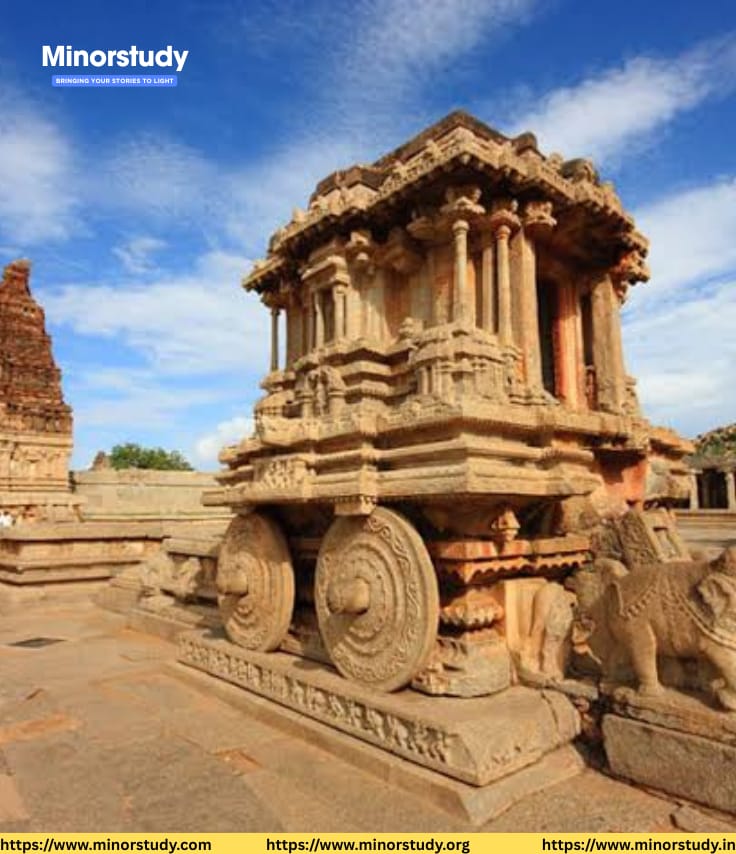🛕 Introduction: A Living Masterpiece of Stone and Soul
Nestled within the ruins of Hampi, Karnataka, the Vijaya Vittala Temple is not just a monument; it is an architectural symphony of stone, echoing stories of grandeur, devotion, and timeless artistry. Built during the pinnacle of the Vijayanagara Empire, this temple is famed for its musical pillars, stone chariot, and celestial design.
- 🛕 Introduction: A Living Masterpiece of Stone and Soul
- 🕰️ History of Vijaya Vittala Temple
- 📌 Key Facts About Vijaya Vittala Temple
- 📜 Timeline of Vijaya Vittala Temple
- ❓ Frequently Asked Questions (FAQs)
- 🌟 Significance of Vijaya Vittala Temple
- 🎉 Observance and Tourism
- 💌 Wishing and Blessings from Vijaya Vittala Temple
- 🔍 Importance in Our Daily Life
- 1. Cultural Identity
- 2. Spiritual Motivation
- 3. Architectural Inspiration
- 4. Tourism and Economy
- 5. Symbol of Unity
- 📖 Important Points to Remember
- 🌈 Positive Societal Impact
- 🧘♂️ Human Reflection: A Temple That Teaches Resilience
- 🔚 Conclusion: When Stones Speak, We Listen
- 🙏 Wishing You the Wisdom of the Temple
If you ever seek to feel the pulse of ancient Indian temple architecture fused with spiritual devotion and cultural legacy, Vijaya Vittala Temple is where the stones breathe history.
🕰️ History of Vijaya Vittala Temple
The Vijaya Vittala Temple was primarily constructed during the reign of King Devaraya II (1422–1446 AD) of the Vijayanagara Empire, but it reached its zenith under the famous king Krishnadevaraya (1509–1529 AD).
Vittala, a form of Lord Vishnu, was worshipped as a deity of prosperity and victory.
The temple complex was part of a flourishing capital that was once described by Portuguese travellers as “larger than Rome.”
This temple wasn’t just a religious center but also a cultural hub for dance, music, and intellectual exchanges.
📌 Key Facts About Vijaya Vittala Temple
🎵 Musical Pillars: 56 pillars emit musical tones when tapped gently—each tone resembling a different instrument.
🚩 Stone Chariot: Inspired by the Konark Sun Temple, the chariot here is an iconic symbol of Hampi and is featured on Indian currency notes (₹50).
🏛️ Dravidian Architecture: Showcases exceptional craftsmanship with high gateways, detailed mandapas (halls), and spiritual iconography.
🧱 Unfinished Glory: Despite its splendor, the temple remains incomplete, possibly due to invasions or sudden decline of the empire.
🌐 UNESCO World Heritage Site: Part of the Hampi Group of Monuments, it is globally recognized for cultural heritage.
🕊️ No Idol in Garbhagriha: The sanctum sanctorum is currently empty, symbolizing spiritual loss due to historical invasions.
🧭 Perfect Orientation: The layout of the temple aligns with astronomical and religious precision, like the solstice shadows.
📜 Timeline of Vijaya Vittala Temple
| Year/Period | Event |
|---|---|
| 1422 AD | Initial construction under King Devaraya II begins |
| 1509–1529 | Major expansion by Krishnadevaraya |
| 1565 AD | Battle of Talikota – decline of Vijayanagara Empire |
| 16th–18th c. | Temple suffers damages, idol removed |
| 1986 | Declared part of UNESCO World Heritage site |
| Present Day | One of the most visited historical temples in South India |
❓ Frequently Asked Questions (FAQs)
Q1: Who built the Vijaya Vittala Temple?
A: Primarily built under King Devaraya II and expanded by Krishnadevaraya.
Q2: What is the temple famous for?
A: Its musical pillars, stone chariot, and architectural brilliance.
Q3: Is the temple still used for worship?
A: No, it is now a protected monument without active rituals.
Q4: Why is the temple incomplete?
A: Due to sudden collapse of the empire post-Battle of Talikota.
Q5: Where is Vijaya Vittala Temple located?
A: In Hampi, Karnataka, India.
🌟 Significance of Vijaya Vittala Temple
The Vijaya Vittala Temple goes beyond bricks and mortar:
It represents the golden age of South Indian temple architecture.
It symbolizes the intersection of devotion and scientific thought—especially with its sound-emitting pillars.
It stands as a monument of imperial grandeur and cultural resilience.
It reflects a period when art and religion coexisted seamlessly.
🎉 Observance and Tourism
Even though religious observances are no longer performed here, the temple remains a place of spiritual admiration and historical tourism.
Many pilgrims still visit Hampi and spiritually connect with the temple’s aura.
Annual Hampi Utsav celebrates the cultural legacy of Vijayanagara, featuring dances, dramas, and lights illuminating the temple complex.
💌 Wishing and Blessings from Vijaya Vittala Temple
Even in silence, the Vijaya Vittala Temple whispers divine wishes. Visitors often say:
“May the strength of this temple bring harmony to our lives,
as these stones stood the test of time, so may we too.”
While you can’t offer traditional puja, you can still close your eyes in front of the Stone Chariot and wish for:
Victory in endeavors (true to its name “Vijaya”),
Intellectual inspiration (thanks to its scholarly past),
Inner peace (in the temple’s serene atmosphere).
🔍 Importance in Our Daily Life
How does an ancient stone temple still impact us today?
1. Cultural Identity
Vijaya Vittala Temple helps us rediscover our roots—a reminder of the glories of Indian civilization.
2. Spiritual Motivation
Though not active for worship, it is a source of silent spiritual energy for modern seekers.
3. Architectural Inspiration
Its use of acoustic science, symmetry, and sustainable stone design inspires architects and historians alike.
4. Tourism and Economy
It generates local employment, promotes craft-based souvenirs, and boosts Karnataka’s tourism.
5. Symbol of Unity
The temple represents inclusive Hindu culture, where music, dance, art, and intellect were celebrated together.
📖 Important Points to Remember
Never miss the Stone Chariot and Musical Pillars—they are engineering marvels.
Visit during early morning or golden hour to feel the sun-kissed heritage.
Photography is allowed, but respect the sanctity of the site.
The temple has no entry fee, but local guides may enhance your experience.
🌈 Positive Societal Impact
Vijaya Vittala Temple contributes to:
Educational enrichment – studied in architecture and history curriculums.
Cultural awareness – featured in documentaries and heritage walks.
Preservation efforts – inspires the youth to conserve India’s treasures.
🧘♂️ Human Reflection: A Temple That Teaches Resilience
In today’s fast-paced digital life, the Vijaya Vittala Temple is a pause button, helping us reflect on:
How creativity flourishes in devotion,
How resilience survives invasions and time,
How silence can still echo with timeless music.
It urges us to ask: What will we leave behind?
🔚 Conclusion: When Stones Speak, We Listen
The Vijaya Vittala Temple is not just a tourist spot—it’s a living classroom, spiritual escape, and national pride. It teaches us that beauty, devotion, and innovation can stand tall even in ruins.
So, next time you feel disconnected from roots or creativity, just picture the Stone Chariot basking in golden sunlight, and remember:
We come from a legacy of wonders.
🙏 Wishing You the Wisdom of the Temple
May the blessings of Lord Vittala guide your path.
May your efforts sing like the musical pillars—graceful and impactful.
May your dreams be as strong and enduring as the stones of this temple.








